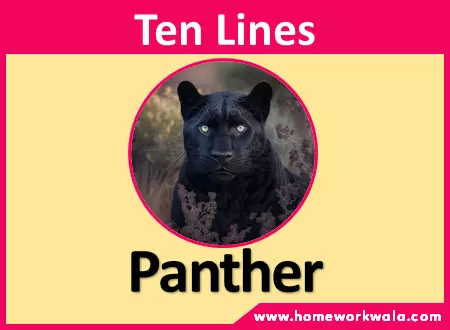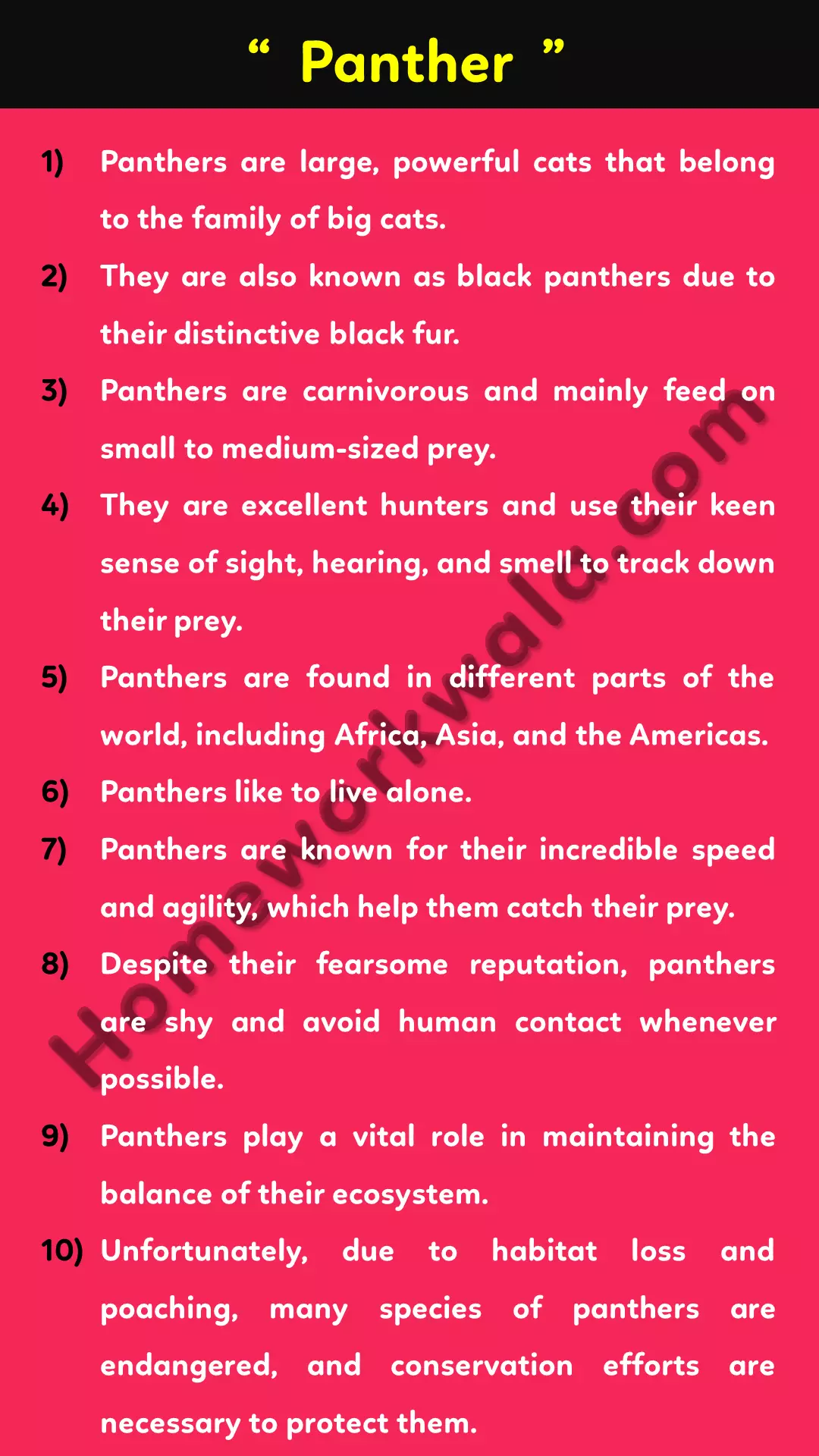Table of Content
Through this article, we are sharing 10 lines on Panther in English. This post will help those students who are looking for information about Panther in the English Language.
If any student wants to write a short essay on Panther then, this post is very useful for them. Information about Panther is very simple and easy for writing purposes.
These sentences on Panther are very short and easy to understand, so any level of student can write on this topic.

Short essay on Panther in English ( In 3 Formats )
Format-1
- Panthers are large, powerful cats that belong to the family of big cats.
- They are also known as black panthers due to their distinctive black fur.
- Panthers are carnivorous and mainly feed on small to medium-sized prey.
- They are excellent hunters and use their keen sense of sight, hearing, and smell to track down their prey.
- Panthers are found in different parts of the world, including Africa, Asia, and the Americas.
- Panthers like to live alone.
- Panthers are known for their incredible speed and agility, which help them catch their prey.
- Despite their fearsome reputation, panthers are shy and avoid human contact whenever possible.
- Panthers play a vital role in maintaining the balance of their ecosystem.
- Unfortunately, due to habitat loss and poaching, many species of panthers are endangered, and conservation efforts are necessary to protect them.
You May Also Like
Format-2
- Panthers are also known as leopards or jaguars depending on the region they are found in.
- They have sharp claws and teeth, which they use to hunt and defend themselves.
- Panthers have excellent night vision, which helps them hunt in the dark.
- Their black fur helps them blend into their surroundings and avoid detection.
- Panther like to live alone in the jungle and hunts alone.
- They communicate through vocalizations, such as growls, hisses, and purrs.
- Panthers are apex predators, which means they have no natural enemies in their habitat.
- They are also agile climbers and can climb trees to rest or escape danger.
- Panthers are territorial and mark their territory with scent markings and scratch marks.
- Panthers are revered in many cultures, and their images feature myths, legends, and folklore around the world.
Format-3
- Panthers are very athletic and can jump up to 20 feet in one leap.
- They have powerful hind legs that allow them to pounce on their prey with great force.
- Panthers are ambush predators, which means they wait and watch for their prey to get close before attacking.
- Their sharp claws are retractable, which helps them move stealthily without making any noise.
- Panthers have a keen sense of smell that helps them detect prey from far away.
- They can run at speeds of up to 50 miles per hour when chasing their prey.
- Panthers are adaptable animals and can survive in a wide range of habitats, including forests, grasslands, and even deserts.
- They are also strong swimmers and can cross rivers and lakes to hunt or explore new areas.
- Panthers have a long lifespan and can live up to 12-15 years in the wild.
- Panthers are apex predators and play a crucial role in maintaining the balance of their ecosystem by regulating the populations of their prey.

FAQ
- What is a panther?
- Where do panthers live?
- What do panthers eat?
- Are panthers endangered?
- How do the panthers communicate?
- How fast can the panthers run?
- Are panthers dangerous to humans?
- How long do the panthers live?
- Why are panthers important to their ecosystem?
- How can we help protect panthers?
A panther is a large, powerful big cat that belongs to the family of Felidae. It is also known as a black panther due to its distinctive black fur.
Panthers are found in different parts of the world, including Africa, Asia, and the Americas. They prefer to live in habitats such as forests, grasslands, and wetlands.
Panthers are carnivorous and mainly feed on small to medium-sized prey, such as deer, wild boars, and smaller mammals. They are also known to eat birds, fish, and reptiles.
Yes, many species of panthers are endangered due to habitat loss, poaching, and other human activities. For example, the Florida panther is a critically endangered species with a population of fewer than 200 individuals.
Panthers communicate through vocalizations, such as growls, hisses, and purrs. They also use body languages, such as tail flicks and ear movements, to convey messages.
Panthers are very fast runners and can reach speeds of up to 50 miles per hour when chasing their prey.
Panthers generally avoid human contact and are not a significant threat to humans. However, like any wild animal, they can become aggressive if they feel threatened or cornered.
Panthers have a long lifespan and can live up to 12-15 years in the wild. However, their lifespan can vary depending on factors such as habitat quality, prey availability, and human impacts.
Panthers play a crucial role in maintaining the balance of their ecosystem by regulating the populations of their prey. They also help to maintain the health of their habitat by controlling the populations of other animals.
We can help protect panthers by supporting conservation efforts, such as habitat restoration, anti-poaching initiatives, and public education programs. We can also reduce our impact on their habitat by practicing sustainable lifestyles and reducing our carbon footprint.
We hope! You will get some learning through this article. If you really like this article about Panther in English, then please share it with your friends.
We working on helping the students to do their homework in a simple and easy way. Essay writing on Panther is generally asked the students in Schools.